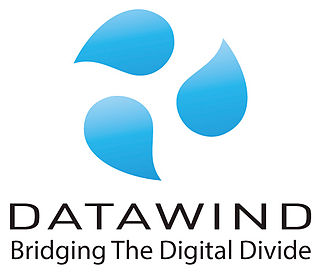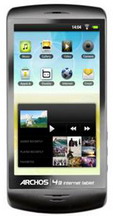Archos is a French multinational electronics company that was established in 1988 by Henri Crohas. Archos manufactures tablets, smartphones, portable media players and portable data storage devices. The name is an anagram of Crohas' last name. Also, in Greek (-αρχος), it's a suffix used in nouns indicating a person with power. The company's slogan has been updated from "Think Smaller" to "On The Go", and the current "Entertainment your way".

A tablet computer, commonly shortened to tablet, is a mobile device, typically with a mobile operating system and touchscreen display processing circuitry, and a rechargeable battery in a single, thin and flat package. Tablets, being computers, have similar capabilities, but lack some input/output (I/O) abilities that others have. Modern tablets largely resemble modern smartphones, the only differences being that tablets are relatively larger than smartphones, with screens 7 inches (18 cm) or larger, measured diagonally, and may not support access to a cellular network. Unlike laptops, tablets usually run mobile operating systems, alongside smartphones.

BumpTop was a 3D desktop environment that simulates the normal behavior and physical properties of a real-world desk and enhances it with automatic tools to organize its contents. It is aimed at stylus interaction, making it more suitable for tablet computers and handheld PCs. It was created at the University of Toronto as Anand Agarawala's master's thesis. Agarawala also gave a presentation at the TED conference about his idea. The 1.0 version was released on April 8, 2009, along with a fully featured pro version as a paid upgrade. On April 30, 2010 the author announced that BumpTop was being discontinued and that they were taking the software "in an exciting new direction." Two days later, it was announced that the company had been acquired by Google. On January 5, 2011, Google released a sneak preview video of Android 3.0 Honeycomb showing a 3D desktop with features purportedly taken from BumpTop.

A mobile Internet device (MID) is a multimedia capable mobile device providing wireless Internet access. They are designed to provide entertainment, information and location-based services for personal or business use. They allow 2-way communication and real-time sharing. They have been described as filling a niche between smartphones and tablet computers.
Android is a mobile operating system based on a modified version of the Linux kernel and other open-source software, designed primarily for touchscreen mobile devices such as smartphones and tablets. Android is developed by a consortium of developers known as the Open Handset Alliance, though its most widely used version is primarily developed by Google. It was unveiled in November 2007, with the first commercial Android device, the HTC Dream, being launched in September 2008.
The Ångström distribution is a defunct Linux distribution for a variety of embedded devices. The distribution is the result of work by developers from the OpenZaurus, OpenEmbedded, and OpenSIMpad projects. The graphical user interfaces (GUIs) available are OPIE and GPE among other options.
A mobile operating system is an operating system used for smartphones, tablets, smartwatches, smartglasses, or other non-laptop personal mobile computing devices. While computers such as typical/mobile laptops are "mobile", the operating systems used on them are generally not considered mobile, as they were originally designed for desktop computers that historically did not have or need specific mobile features. This line distinguishing mobile and other forms has become blurred in recent years, due to the fact that newer devices have become smaller and more mobile unlike hardware of the past. Key notabilities blurring this line are the introduction of tablet computers, light-weight laptops, and the hybridization of the two in 2-in-1 PCs.
This is a list of tablet computers, grouped by intended audience and form factor.
The Archos Generation 6 (Gen6) product series is represented by misc "Internet Media Tablets" or "IMT", e.g. the Archos 5 Internet Media Tablet This series of tablet computers developed by the French company Archos that features a resistive touchscreen for video, photo, audio, internet browsing and other multimedia applications. The individual numbering of the distinct models seems up to now to roughly resemble the length of the display diagonal in inches.
Rooting is the process by which users of Android devices can attain privileged control over various subsystems of the device, usually smartphones and tablets. Because Android is based on a modified version of the Linux kernel, rooting an Android device gives similar access to administrative (superuser) permissions as on Linux or any other Unix-like operating system such as FreeBSD or macOS.

The BlackBerry PlayBook was a mini tablet computer developed by BlackBerry and made by Quanta Computer, an original design manufacturer (ODM). It was first released for sale on April 19, 2011, in Canada and the United States.
The Archos Generation 7 (Gen7) product series is represented by misc "Internet Tablets" or "IT", e.g. the Archos 5 Internet Tablet. This series of tablet computers developed by the French company Archos that features a resistive touchscreen for video, photo, audio, internet browsing and other multimedia applications. The individual numbering of the distinct models seems up to now to roughly resemble the length of the display diagonal in inches.
The history of tablet computers and the associated special operating software is an example of pen computing technology, and thus the development of tablets has deep historical roots. The first patent for a system that recognized handwritten characters by analyzing the handwriting motion was granted in 1914. The first publicly demonstrated system using a tablet and handwriting recognition instead of a keyboard for working with a modern digital computer dates to 1956.

The Nook Color is a tablet computer/e-reader that was marketed by Barnes & Noble. A 7-inch (18 cm) tablet with multitouch touchscreen input, it is the first device in the Nook line to feature a full-color screen. The device is designed for viewing of books, newspapers, magazines, and children's picture books. A limited number of the children's books available for the Nook Color include interactive animations and the option to have a professional voice actor read the story. It was announced on 26 October 2010 and shipped on 16 November 2010. Nook Color became available at the introductory price of US$249. In December 2011, with the release of the Nook Tablet, it lowered to US$169. On 12 August 2012, the price lowered to US$149. On 4 November 2012, the price was further lowered to US$139. The tablet ran on Android.

The ARCHOS 70 Internet Tablet is part of the Archos Generation 8 range, distributed between 2010 and 2011. It is a 7 inches (18 cm) tablet computer running Android.

The ViewSonic G Tablet is an Android-based tablet produced by ViewSonic Corporation, a manufacturer and provider of visual technology. It first appeared for consumer purchase at Sears on 1 November 2010.

The ARCHOS 101 Internet Tablet is part of the Archos Generation 8 tablet range, distributed between 2010 and 2011. After a hardware upgrade, it was also part of Generation 9 range sold between 2011 and 2012. It is a 10.1 inch (256.5 mm) Internet tablet with dual-boot capability running Android out of the box.

Jeotex, Inc. was an Canadian company that specializing in the development and manufacturing of low-cost tablet computers and smartphones. Founded in Montreal, Quebec, the company aimed to produce tablets primarily for markets in India, Nigeria, the United Kingdom, Canada, and the United States. Joetex gained recognition for creating the "world's cheapest tablet" the Aakash tablet computer, priced at US$37.99 per unit. The Aakash was developed for India's Ministry for Human Resource Development (MHRD).

The Archos GamePad is a video gaming tablet developed and marketed by Archos. It runs on the Android operating system. It was announced on August 29, 2012 and was first released on 6 December 2012 in Europe, with a US release projected for February 2013. The tablet is aimed at gaming, and features dedicated dual analog sticks along with regular gaming keys and shoulder buttons - a similar design as the PlayStation Vita. Archos have designed a technology which 'converts' the touch controls into physical controls from the buttons. It is able to get over a thousand games from the Google Play library.










